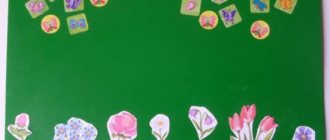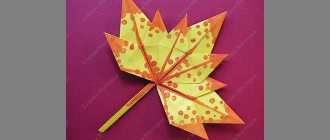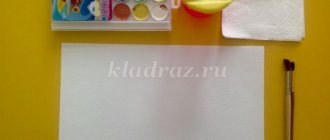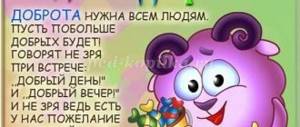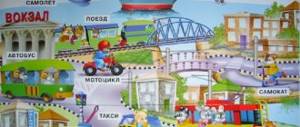Summary of GCD for drawing in the senior group “Drawing a tree”
Topic: Drawing a tree
Goals:
teach children to perceive the content of works of art, to understand the beauty of nature; introduce the work of I.I. Levitan; improve the ability to depict objects from memory; drawing and coloring techniques with pencils; develop the ability to notice color changes in nature; cultivate a caring attitude towards trees.
Equipment:
reproduction of the painting “Birch Grove” by I.I. Levitan, easel, flannelgraph, figures for flannelgraph (images of birch, oak, willow); simple and colored pencils; paper.
Preliminary preparation:
During the walk, the teacher draws the children’s attention to the fact that trees of different species have significant differences: the color of the bark, the shape of the crown, the shape of the trunk and other characteristics.
Progress of the lesson
- I. Conversation on the picture.
- Educator:
Many famous artists loved to paint nature. They chose very beautiful places, admired them, and then shared their joy with us by drawing beautiful pictures. Here is one of them in front of you. - The teacher invites the children to look at the picture of I.I. L evitan "Birch Grove"
- -
Look how beautiful the nature captured by the artist is.
What did the artist draw? What trees did the artist paint? What time of year and what time of day is shown in the picture? How did you figure this out? What colors are used to paint this picture? Do you like this picture? ( Children's answers) - — Yes, this painting by Isaac Levitan is called “Birch Grove.” There is so much light and joy in her. That is why she has been delighting many people who admire her in the museum for many years.
- II . Updating knowledge.
- Educator.
It is not easy to draw the way the artist did it. All famous artists had to study for a long time and draw a lot, depicting objects so that they looked like real ones. So you and I will learn to draw different trees so that everyone can immediately recognize them. But first, let's see how they differ. Listen to the riddle: - I dropped my curls into the river
- And I was sad about something,
- What is she sad about?
- Doesn't tell anyone.
- - What tree is the riddle about? ( Children’s answers)
That’s right, it’s a willow. - The teacher attaches a picture of a willow to the flannelgraph
- -What curls did the willow drop?
- -What kind of leaves does a willow have? ( Children’s answers)
- -Here are more riddles about a tree that is well known to you.
- There are white pillars,
- They have green hats,
- Hairy in summer,
- Gnarled in winter.
- Where they stand is where they make noise.
- Or
- The sisters are standing in the field,
- henbane dresses,
- The caps are green.
- - What tree are they talking about in these riddles? (Children's answers)
Of course, about birch trees. - The teacher attaches a picture of a birch tree to the flannelgraph.
- - Why do they say about these trees “white-trunked” or “white pillars”?
- -What other signs can we use to recognize a birch tree? How are the branches of a birch tree arranged? What kind of leaves does a birch have? (Children's answers)
- And this riddle is about a tree beloved by many.
- I crawled out of the little barrel,
- Sent roots and grew up,
- I have become tall and mighty,
- I'm not afraid of thunderstorms or clouds.
- I feed pigs and squirrels
- It’s okay that my fruit is small.
- -What kind of tree grows from such a seed? (The teacher shows the children an acorn.) (Children's answers)
Of course, it's an oak tree. - The teacher attaches an image of an oak tree to the flannelgraph
- — Why do they say about oak “mighty tree” ?
What kind of leaves does it have?
What trunk? (Children's answers) - — As you can see, each tree has its own characteristics. One has branches downwards, the other ones look up. Birch bark is white and smooth, while oak bark is thick and wrinkled. All these differences must be displayed in the drawing so that the drawn tree is recognizable.
- III. Demonstration of working methods.
- Educator.
Let's start our drawing by determining how we need to position the sheet of paper: horizontally or vertically. I'll place the sheet horizontally because I want to draw three trees on it. Then I will draw the outlines of the trees with a simple pencil using thin lines. After this, I will select pencils of the desired color and color the tree trunks, draw the leaves, and also do not forget to draw the ground, otherwise our trees will “hang in the air” without roots. - During the story, the teacher shows the children techniques for drawing different trees.
- IV. Practical work
- Children draw willow, birch, oak.
- V. Summary of the lesson.
- Children's drawings are displayed at the stand.
- Educator.
What a miracle - a forest grew in our group. Mighty oaks, cheerful birches, sad willows - they are all different, but we need them so much. Trees decorate our land. They make many useful things: furniture, boats, paper, pencils, etc. Trees are very important to us. Therefore, we must take care of every twig, every sprout. Without forests, life on Earth would simply be impossible. - And in the rain and in the heat
- This friend will help
- So green and good -
- Will stretch out dozens of hands to us
- And thousands of palms.
Practical part
Form of the lesson
Drawing takes place in the form of direct educational activities (DEA). This involves a process in which the adult mentor and the children make joint efforts.
Everything about preparing children for school on your own
Advice! A distinctive feature of preschoolers is their ability to imitate. Therefore, it is especially important that the teacher draws out all the stages step by step and explains his own actions in detail.
- before starting the process, you need to name the type of paint (gouache);
- remind you how to hold a brush correctly;
- once again show in the air the movements characteristic of working with a brush and a cotton swab;
- tell what a palette is, what it is needed for, how to mix white and blue gouache on a palette to get a blue tint;
- Remind the children not to forget to rinse and dry the brush.
Musical accompaniment
Many modern children suffer from hyperactivity. This quality prevents them from concentrating on work, being collected and focused. Loud music and a cheerful song will interfere with the internal organization of the children. It will be more difficult for them to immerse themselves in the creative process. The lesson will be more constructive in a quiet, calm environment. In this case, both the teacher’s explanations and the children’s questions will be better heard.
Step by step drawing process
- You need to start the drawing in the middle of the sheet with the image of a tree trunk. Movement from top to bottom. This is done using brown paint.
- Then the branches are drawn. They reach up to the sky. First you need to draw long branches coming from the tree trunk. Then add small short branches to them.
- Using a clean brush, mix the blue color on the palette. Use this paint to paint the snowdrifts and the underlying surface under the tree.
- Using the same paint, using a cotton swab, use the poking technique to paint the frost lying on the branches.
